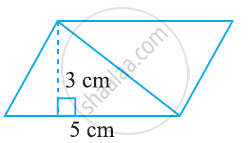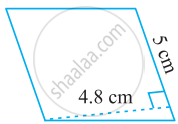Advertisements
Advertisements
प्रश्न
Find the area of the following parallelogram:

उत्तर
Area of parallelogram = Base × Height
Height = 3 cm
Base = 5 cm
Area of parallelogram = 5 × 3
= 15 cm2
APPEARS IN
संबंधित प्रश्न
Find the area of the following parallelogram:

PQRS is a parallelogram (see the given figure). QM is the height from Q to SR and QN is the height from Q to PS. If SR = 12 cm and QM = 7.6 cm. Find:
- the area of the parallelogram PQRS
- QN, if PS = 8 cm

If base of a parallelogram is 18 cm and its height is 11 cm, find its area.
The adjacent sides of a parallelogram are 21 cm and 28 cm. If it's one diagonal is 35 cm; find the area of the parallelogram.
The two sides of the parallelogram ABCD are 6 cm and 4 cm. The height corresponding to the base CD is 3 cm.
Find the
(i) area of the parallelogram.
(ii) the height corresponding to the base AD.

The area of parallelogram whose base 10 m and height 7 m is
Find the height of the parallelogram whose base is four times the height and whose area is 576 sq.cm
In the given figure, find the area of parallelogram ABCD, if the area of shaded triangle is 9 cm2.

Altitudes MN and MO of parallelogram MGHK are 8 cm and 4 cm long respectively in the below figure. One side GH is 6 cm long. Find the perimeter of MGHK.

ABCD is a parallelogram in which AE is perpendicular to CD as shown in the given figure. Also, AC = 5 cm, DE = 4 cm and area of ΔAED = 6 cm2. Find the perimeter and area of parallelogram ABCD.
